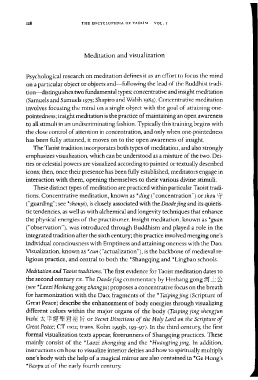Page 158 - The Encyclopedia of Taoism v1_A-L
P. 158
lIS THE ENCYCLOPEDIA OF TAOISM VOL. I
Meditation and visualization
Psychological research on meditation defines it as an effort to focus the mind
on a particular object or objects and-following the lead of the Buddhist tradi-
tion-distinguishes two fundamental types: concentrative and insight meditation
(Samuels and Samuels 1975; Shapiro and Walsh 1984). Concentrative meditation
involves focusing the mind on a single object with the goal of attaining one-
pointedness; insight meditation is the practice of maintaining an open awareness
to all stimuli in an undiscriminating fashion. Typically this training begins with
the close control of attention in concentration, and only when one-pointedness
has been fully attained, it moves on to the open awareness of insight.
The Taoist tradition incorporates both types of meditation, and also strongly
emphasizes visualization, which can be understood as a mixture of the two. Dei-
ties or celestial powers are visualized according to painted or textually described
icons; then, once their presence has been fully established, meditators engage in
interaction with them, opening themselves to their various divine stimuli.
These distinct types of meditation are practiced within particular Taoist tradi-
tions. Concentrative meditation, known as *ding ("concentration") or shou ',1'
("guarding"; see * shouyi), is closely associated with the Daode jing and its quietis-
tic tendencies, as well as with alchemical and longevity techniques that enhance
the physical energies of the practitioner. Insight meditation, known as *guan
("observation"), was introduced through Buddhism and played a role in the
integrated tradition after the sixth century; this practice involved merging one's
individual consciousness with Emptiness and attaining oneness with the Dao.
Visualization, known as *cun ("actualization"), is the backbone of medieval re-
ligious practice, and central to both the *Shangqing and *Lingbao schools.
Meditation and Taoist traditions. The first evidence for Taoist meditation dates to
the second century CE. The Daode jing commentary by Heshang gong ~PJ ..t 0-
(see *Laozi Heshanggong zhangju) proposes a concentrative focus on the breath
for harmonization with the Dao; fragments of the *Taipingjing (Scripture of
Great Peace) describe the enhancement of body energies through visualizing
different colors within the major organs of the body (Taiping jing shengjun
bizhi A 'f ~ .J':\IUg- 1>1:':, ff or Secret Directions of the Holy Lord on the Scripture of
Great Peace; CT 1102; trans. Kohn 1993b, 193-97). In the third century, the first
formal visualization texts appear, forerunners of Shangqing practices. These
mainly consist of the *Laozi zhongjing and the *Huangtingjing. In addition,
instructions on how to visualize interior deities and how to spiritually multiply
one's body with the help of a magical mirror are also contained in *Ge Hong's
*Baopu zi of the early fourth century.

